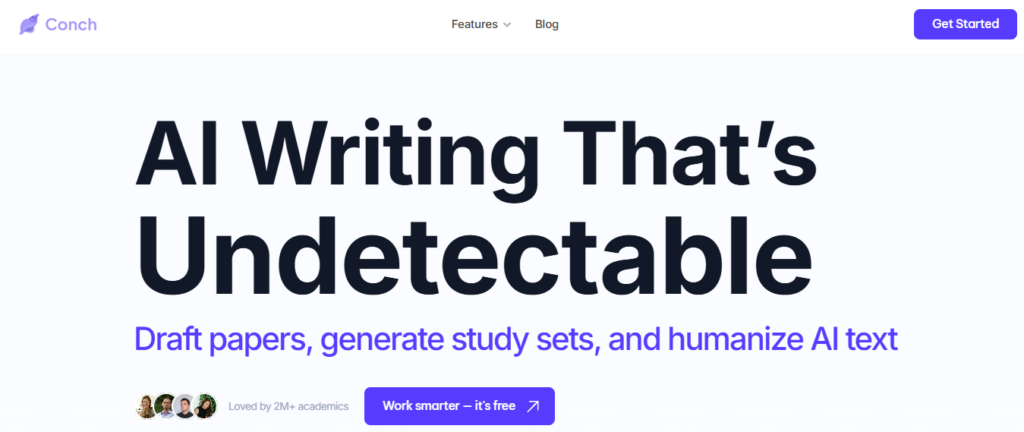When tackling a research paper, it’s easy to overlook textbooks. While they contain valuable information, this material is often outdated and may not meet your instructor’s requirements. Your professor has read the same textbook chapters you are now referencing and would prefer that you use primary sources instead. If your research paper is on a historical topic, you may be wondering, “Are textbooks primary sources?” This guide will explain the answer to this question and outline its significance. We’ll also discuss how to use AI to write a paper and how this can help you find the information you need faster and with less stress.
If you’re looking for a way to make your research process easier, Conch AI’s AI writing tool can help you reach your goals faster. This advanced AI can help you outline your paper, generate a thesis statement, and even write paragraphs so you can focus on what matters: finding and analyzing primary sources.
Are Textbooks Primary Sources?

The straightforward answer is no, textbooks are generally classified as secondary sources, although there are a few exceptions. When exploring historical events or academic topics, understanding the difference between primary and secondary sources is crucial. One common question is whether textbooks qualify as primary sources.
Primary sources are original materials created during the time period being studied. They serve as direct evidence or firsthand accounts of events, ideas, or phenomena. These sources provide raw, unfiltered insights into the subject matter, making them invaluable for original research.
Examples include:
- Letters and diaries written by individuals at the time
- Official documents and records
- Photographs and audio recordings
- Artifacts and objects from the era
- Speeches or interviews conducted during the event
Secondary sources interpret, analyze, or summarize information derived from primary sources. They offer context, explanation, and scholarly perspective rather than firsthand evidence. These materials help readers understand and make sense of primary data by synthesizing multiple pieces of evidence.
Familiar secondary sources include:
- Textbooks
- Scholarly articles and reviews
- Biographies
- Historical commentaries and critiques
Related Reading
- How to Calculate H Index
- How to Write an Informative Essay
- Technology Essay
- How to Write a Header for an Essay
- How to Write a Biography Essay
- How to Write a Reflection Paper
- How to Write an Encyclopedia Entry
- Speech Analysis Example
- What is a Good H Index
What Are Textbooks?

Textbooks are specially designed educational materials that deliver organized information on particular subjects. Their primary purpose is to break down complex ideas into simpler components, making it easier for learners at various stages to grasp the content.
Typically, textbooks are arranged in a logical sequence of chapters, where each section builds on the knowledge introduced earlier. This structured progression helps students follow concepts step-by-step without feeling overwhelmed. To support comprehension, textbooks often incorporate visual elements, including diagrams, charts, and illustrations. These aids complement the written text by providing clear examples and enhancing the learner’s ability to visualize abstract ideas.
Exercises and chapter summaries help reinforce key points and ensure that learners retain what they have studied. More than just instructional tools, textbooks serve as essential foundations in formal education systems. They provide a reliable framework that guides academic development and supports consistent learning outcomes across diverse educational settings.
Tools like Conch AI enhance the learning experience by providing brilliant writing and study tools that complement traditional textbooks, helping students organize ideas and create original content efficiently.
Join Over 2 Million Students and Ace your Classes with our AI Writing Tool
Join millions of students to write papers and ace exams with Conch AI’s AI writing tool. We built this tool because we were tired of spending endless hours on citations, study guides, and rewrites. Unlike general AI tools, Conch AI understands what students need:
- Instant citations that professors accept
- Stealth writing that bypasses detection
- Study tools that help you learn the material
Our Chrome extension brings these superpowers right to your research workflow, while our lecture recording feature takes notes for you so you can focus on understanding concepts. Try our free plan today and see why students tell us they’re saving 10+ hours a week with Conch AI. When you’re ready for unlimited access, our Limitless Plan gives you everything you need to transform your academic experience. Join over 2 million students and ace your classes with our AI writing tool!
When Textbooks are Secondary Sources

Textbooks are generally regarded as secondary sources because they do not present original research or firsthand accounts. Instead, they interpret, analyze, and summarize information derived from primary materials. This distinction is essential for academic research and understanding the nature of information sources.
Here are some examples of when textbooks are secondary sources:
Interpretation and Analysis
Textbooks often synthesize data from multiple primary sources, offering explanations and context rather than new evidence.
Summarization
They condense complex research findings or historical events into accessible formats for learners.
Educational Purpose
The primary goal of textbooks is to teach and clarify established knowledge, rather than presenting novel discoveries.
For example, a history textbook that discusses the causes and outcomes of World War II summarizes and interprets events based on original documents, eyewitness accounts, and scholarly research. Similarly, a science textbook explaining the principles of genetics breaks down research studies into understandable concepts for students.
When Textbooks Can Be Primary Sources

Textbooks are typically considered secondary sources because they summarize, interpret, or analyze information originally presented elsewhere. However, there are specific situations in which textbooks themselves can serve as primary sources. Understanding these exceptions is crucial for researchers and students aiming to use textbooks appropriately in their work. Here are a few situations where textbooks can be considered as primary sources:
Contemporary Textbooks as Historical Evidence
A textbook created during a particular historical period can serve as a primary source because it directly reflects the ideas, knowledge, and instructional methods of that time. For example, a military manual published during World War II designed to teach soldiers battlefield strategies is not just a summary of past knowledge; it is a firsthand artifact revealing how military tactics were taught and understood during the war. Such textbooks provide valuable insight into the mindset and practices of their era.
Textbooks Containing Original Documents
Some textbooks include reproductions of original materials such as letters, official documents, or firsthand narratives. While the textbook as a whole remains a secondary source, these embedded original documents qualify as primary source material. Researchers can analyze these sections directly to gain unfiltered access to historical evidence, making the textbook a hybrid source in these cases.
Textbooks as Cultural and Historical Artifacts
Beyond their content, textbooks themselves can be studied as artifacts that reflect the cultural values, biases, and educational priorities of the time in which they were produced. For instance, a history textbook from the 1950s might reveal prevailing social attitudes, political perspectives, or omissions that characterize that era’s worldview. In this way, textbooks offer a window into the intellectual climate and societal norms of their period, making them primary sources for cultural and historical research.
Related Reading
- Essay on Respect
- Essay About Bullying
- Why I Deserve This Scholarship Essay
- Is Census Data Primary or Secondary
- Is a Documentary a Primary Source
- Essay About Death
- How to Write a 4 Paragraph Essay
- Finance Research Paper Writing
The Importance of Context

Context plays a crucial role in determining how we interpret and use sources, especially when distinguishing between primary and secondary materials. The way a source is classified depends mainly on the circumstances surrounding its creation and the purpose for which it is used.
Purpose of Use
One key factor is the intent behind using a source. For example, a textbook might be treated as a primary source if it is analyzed as a reflection of the time period in which it was written, revealing contemporary attitudes and perspectives. Conversely, if the textbook is used to understand the factual information it presents, it functions as a secondary source, offering interpretation rather than original evidence.
Content Type
The nature of the content also matters. Primary sources contain original materials, such as firsthand accounts, original research data, or direct evidence from the time under study. Secondary sources, on the other hand, interpret, analyze, or summarize these original materials. Therefore, a source’s classification depends on whether it presents raw information or commentary on that information.
Time of Publication
When a source was created relative to the events it describes is another crucial contextual element. A document written contemporaneously with an event is often a primary source, providing direct insight. However, the same document might be secondary if it is used to understand the perspectives of that time rather than the event itself. Later analyses or textbooks written long after events typically serve as secondary sources.
Join Over 2 Million Students and Ace your Classes with our AI Writing Tool

Researching for a paper can be tedious, especially when you have to sift through piles of information to find reliable sources. When you finally locate what you need, there’s a good chance you’ll have to spend even more time rewriting it so that it fits your assignment requirements and passes your instructor’s plagiarism checks.
If you’re lucky, your textbook will contain most of the information you need. But if you’re not, you’ll be forced to look outside your book for additional sources. Instead, why not let Conch AI do the hard work for you? The tool’s research assistant can help you find the information you need to write your paper quickly. It will even rewrite the text so that it sounds like you.
Related Reading
- Ai Annotated Bibliography
- Leadership Essay Examples
- Social Media Argumentative Essay Topics
- Topic Sentence vs Thesis Statement
- Evaluation Essay Examples
- National Honor Society Essay Examples
- Proposal Essay Examples
- Diversity Essay Examples
- Literary Analysis Essay Examples
- Informative Essay Topics
- Dyslexia Writing Examples

Leave a Reply